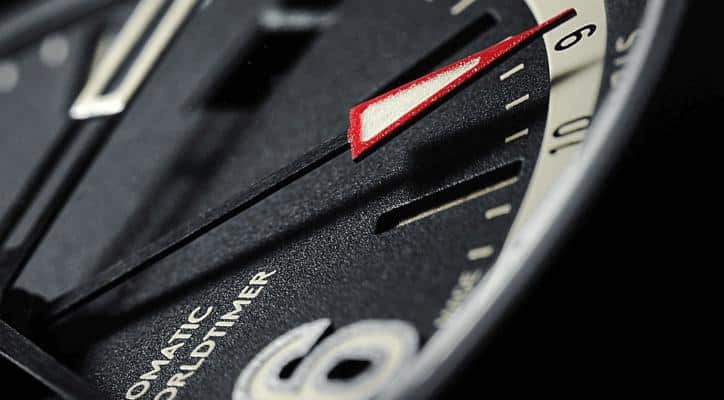
In less than two months, Christopher Ward will start selling the 2016 C8 UTC Worldtimer. Styled as an “aviator” and featuring an appealing combination of a robust Swiss-made movement with their new distinctive approach to design, the new timekeeper is well worth the serious chunk of cash that the watchmaker plans to charge for it.
Overall Impression
I don’t keep track of these things, but I think it’s not the first time that yours truly wants to praise Christopher Ward for the time and effort that it invests into constantly developing its brand. While there is a good deal of small watchmakers that are here for decades, but somehow managed to remain small-time operations, the British company shows visible progress on its way from one of many makers of unimaginative ‘homages’ to a real brand.
While I sort of regret that the process comes hand in hand with a significant rise in prices (that, truth be told, sometimes are outrageously inadequate to their real value,) I also understand that this is sort of inevitable: good designers need to be paid well and good machinery required to make high-grade cases and in-house mechanisms costs tons of money.
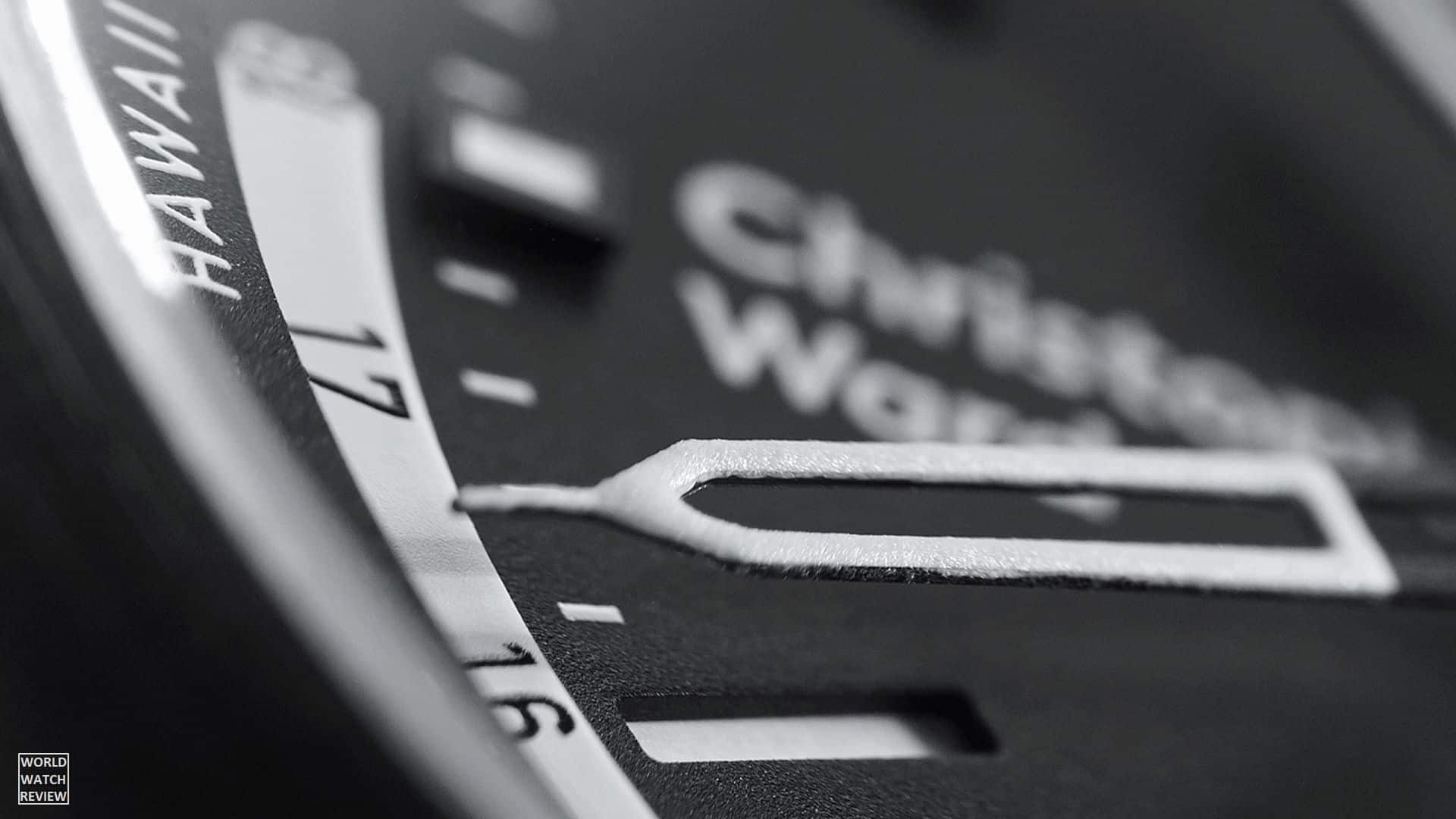
That’s probably the reason why I especially liked this new C8 UTC Worldtimer: while making a significant step forward with the introduction of this collection, the British brand somehow managed to keep the price relatively low (although more than €1100 with local VAT tax included is still nothing to sneeze at) keeping it within reach of an average enthusiast while offering a solid, carefully balanced product that even a lot more established brands wouldn’t be ashamed of.
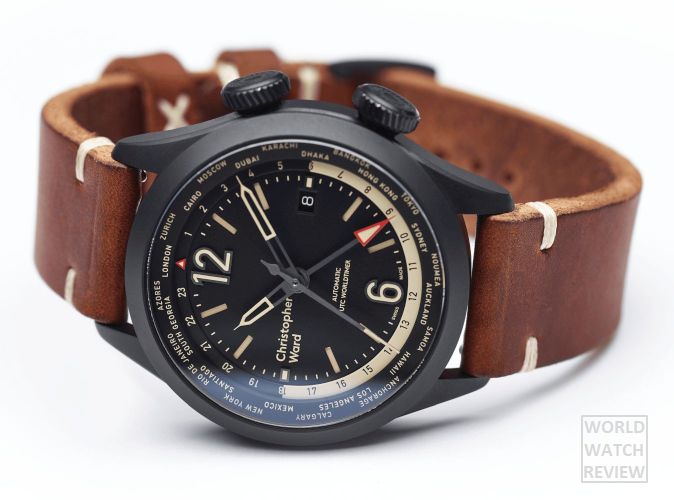
Case & Strap
Styled as a pilot’s watch, the C8 UTC Worldtimer comes in a predictably oversized case that is available both in impressive matte black DLC steel and more traditional plain stainless steel.
While its diameter of 44 millimeters may seem gargantuan to persons with thinner wrists, it is not that large measuring just over 53 millimeters (less than 2.1 inches) in the lug-to-lug department, which makes it just okay for a person in need of a slightly oversized watch who doesn’t want his (or her, who knows) hand to be dwarfed by its sheer massiveness. Also, the thickness of just 11.5 mm, too, makes it a lot more convenient for those who prefer to wear their wristwatches with tight-cuffed shirts or bomber/motorcycle jackets.
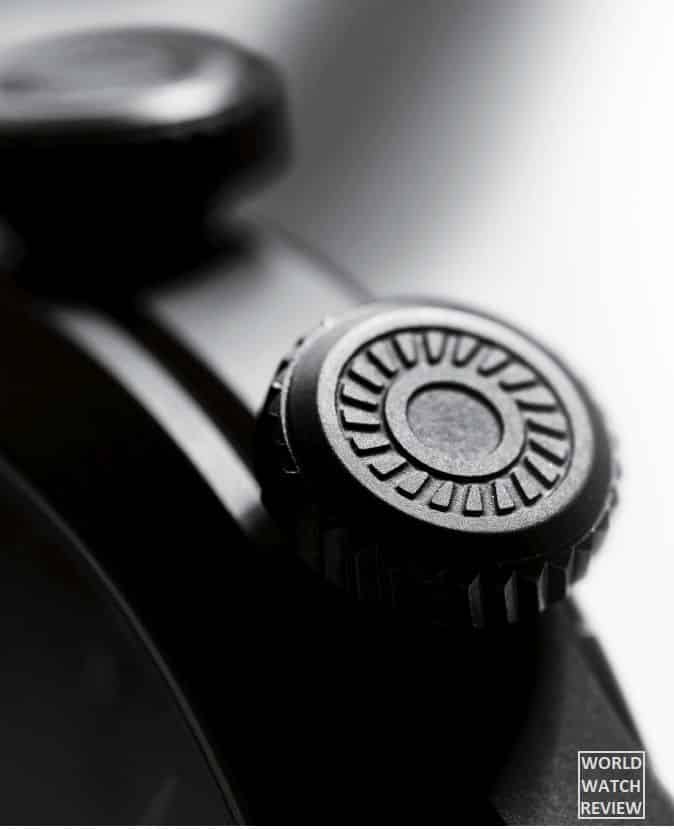
All in all, the case is painstakingly sculpted with surfaces organically ‘flowing’ into each other. Both crowns (one for winding/setting time and the other at two o’clock for manipulating the city disk) are just large enough for the timekeeper to be easily operated, but still not too long to cause any sort of discomfort to those preferring to wear their watches closer to their palms.
As usual, only you can tell whether the watch will fit your wrist or not, but Christopher Ward has a good ‘no questions asked’ return policy, so, unlike it is with many other brands, you will not be stuck with a watch that doesn’t fit and is difficult to resell: yes, sometimes the ‘direct to customers’ approach is a lot more convenient than more traditional means of exchanging money for goods.
As usual, its water resistance rating of just 50 meters (5 ATM) doesn’t impress me much. It could have been okay for a dressier timekeeper, but, given its more military-style appearance (especially if you opt-in for the version in absolutely gorgeous matte black DLC-treated steel,) I would probably expect something no less than 100 meters.
I don’t need it to be suitable even for snorkeling, but I would prefer the piece to sustain some unexpected bathing in a pool or some other body of water. I mean, it must be not particularly pleasant when some clumsy, heavily drunk person pushes you over into a pool with your iPhone and maybe some other electronic gadgets, but when you factor in the price (and maybe emotional value if it’s a present from your loved one) of the watch, it can be murder out there.
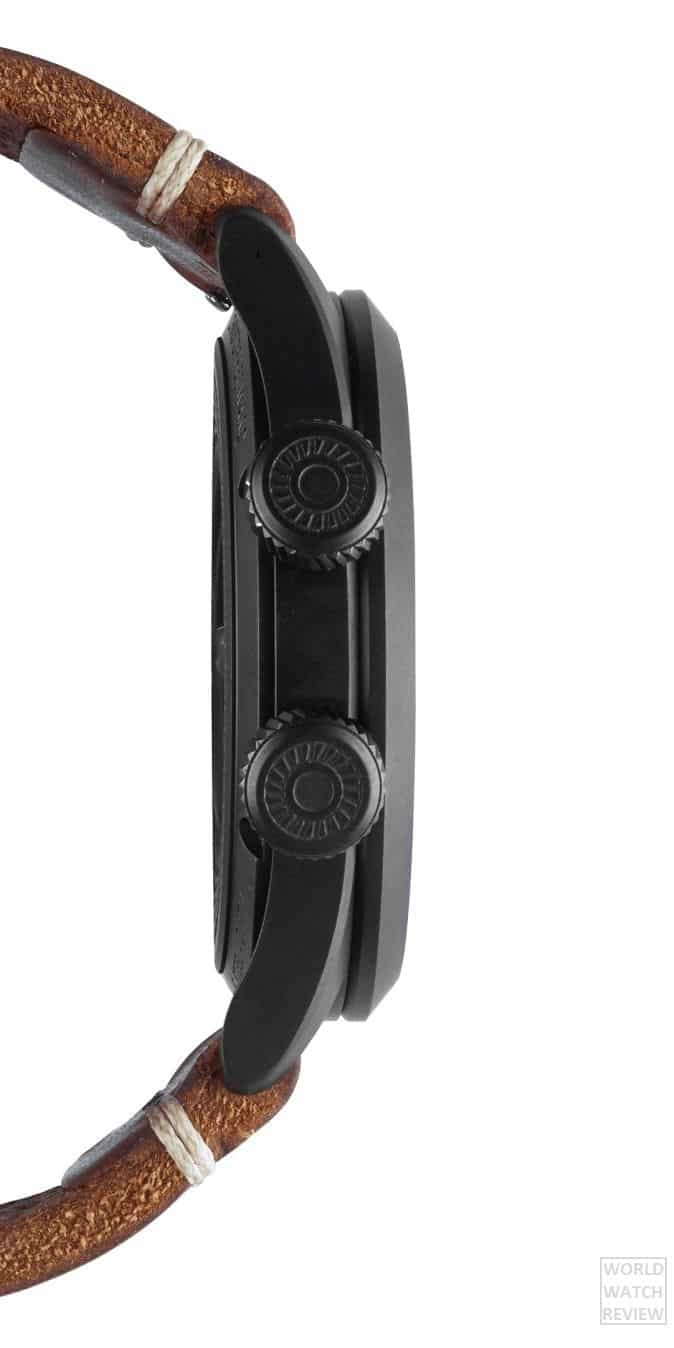
I mean, seriously, is it that hard to make the case more watertight?
I can’t say that I am particularly impressed with the Tibor leather strap: it is too thick and, well, unsophisticated for the watch that otherwise looks that great, and so far, browsing their online store, I can’t see any option to change it for something more convincing. So, if you, like me, are underwhelmed by the part, you would probably have to pay extra for a more interesting strap: luckily, there is a lot to choose from in the 22-mm lug size.
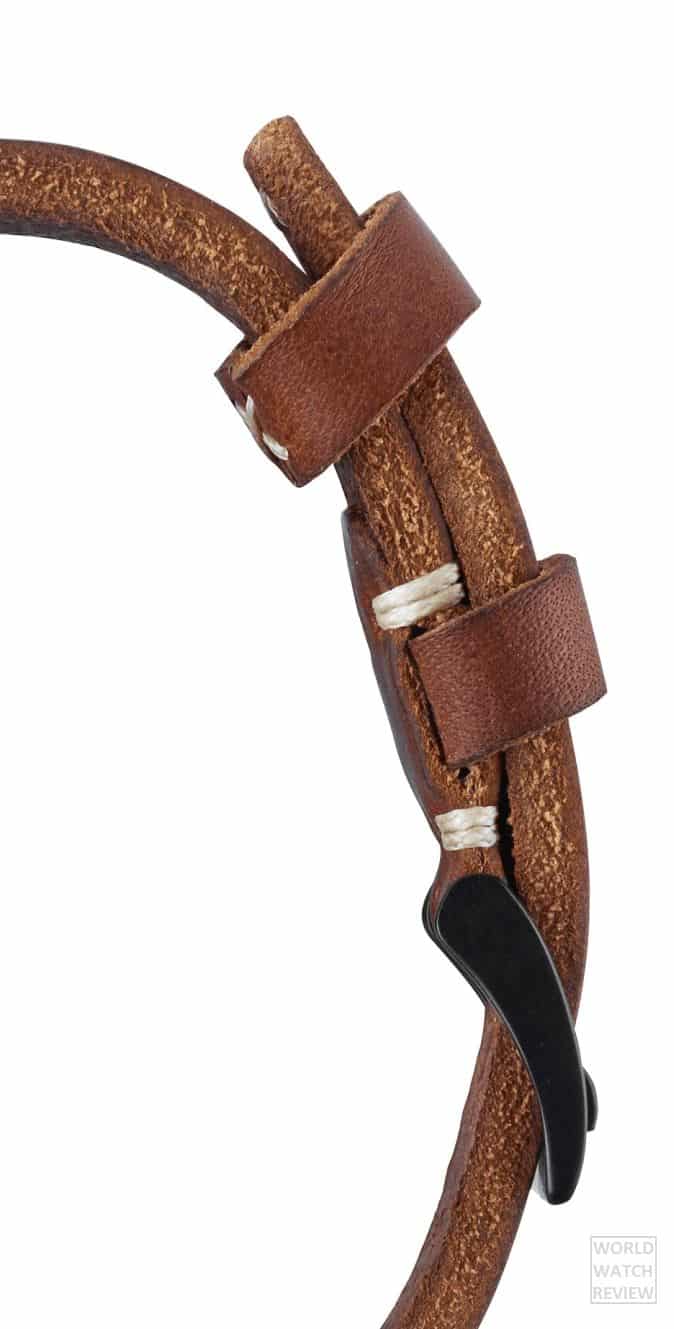
Dial
Just over a year ago, when Chr. Ward started to reinvent itself, the company has announced that it has a new senior designer: a then 27 years old Swiss-born Adrian Buchmann.
According to the brand’s press release disseminated to accompany the news, his “first encounter with Christopher Ward was seeing the C900 Worldtimer [GMT] in an inflight magazine,” so it sort of figures that this new watch designed by mister Buchmann is (a) new Worldtimer model that (b) is styled with clear references to the world of aviation.
While the general layout is more or less standard (what we have here is a usual four-hander with a city disk with major time zones and a date,) it is the signature “pipette” hands that give the piece its distinguished appearance. Featuring an open-worked design, they are partially painted with T-C1 SuperLuminova compound to make them look like, yes, pipettes. Together, they not only look the dial look visually lighter but also provide the Worldtimer with its character in a discreet, even subtle way.
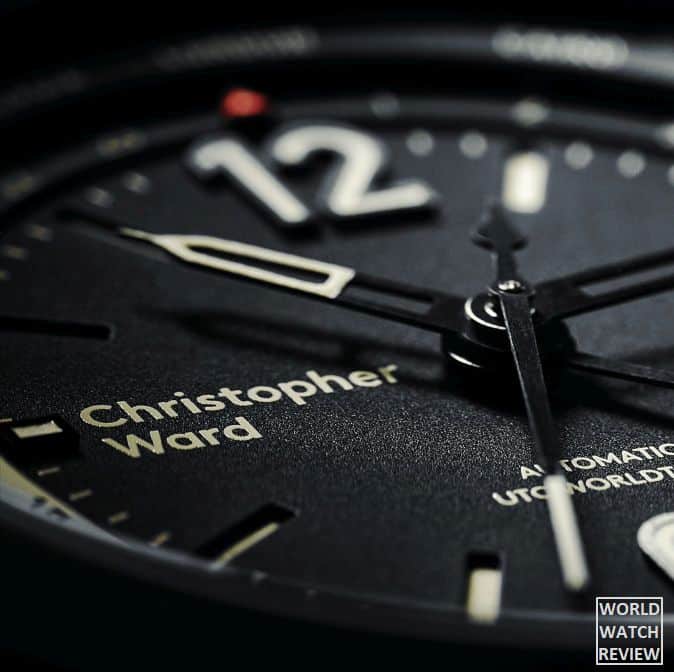
I am not sure whether the design applies to other, less sporty models in the brand’s range, but it would be actually nice to see them in other timekeepers that the British brand plans to reveal in the future.
I also love how ‘three-dimensional’ the face is. The idea of a Panerai-style sandwiched dial with a layer of Superluminova visible through long thin slits was enhanced with three main hour markers (namely, the Arabic six and twelve, as well as a small luminous ‘brick’ at 9 o’clock) rising above the dial to give it an even more prominent appearance.
Both numerals, by the way, are vertically brushed making the piece look even classier than anybody would have expected at first glance.
As far as legibility is concerned, the C8 UTC Worldtimer, too, makes a good impression. The whole idea of a ‘worldtimer’ concept is well-developed by numerous designers who perfected it over the years, so you can’t go wrong here if you know what you are doing. Apparently, mister Buchmann knew what he was doing since the dial is easily readable with all, um, data feeds thoughtfully separated: you don’t have to guess where is what on the dial. The 24-hour display with a standard day/night indicator is easy to read even if you don’t have experience with the military time format.
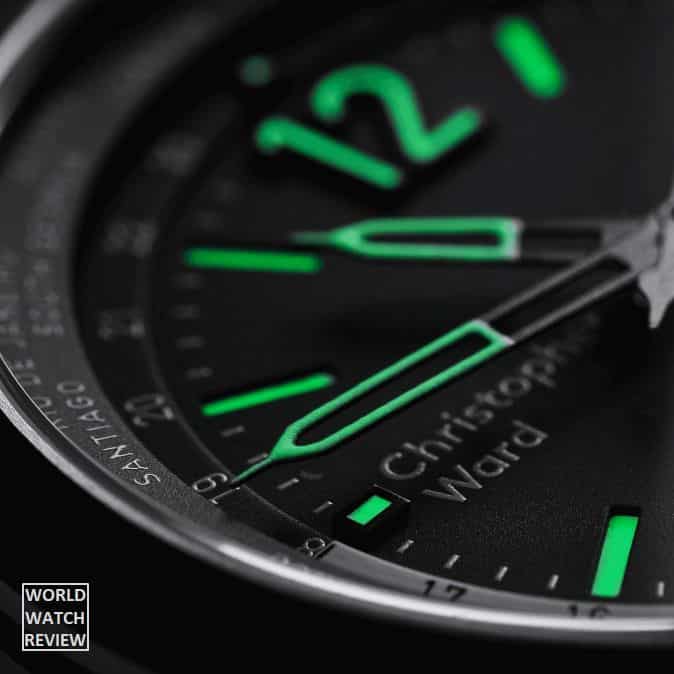
Perhaps, the only thing that I feel lacking here is the absence of lume on the 24-hour scale: it would have been a lot easier to read during those sleepless nights when you, a stranger in a strange land, lay awake in a hotel room while suffering from severe jet lag. On the other hand, the best remedy against jet lag is a good book and most ebook readers have their own clocks, so that doesn’t look like a serious problem to me.
Oh, yes, and the numerals on the calendar wheel are small, but that is the limitation of the movement that powers this otherwise gorgeous timepiece.
Mechanism
Back in 2014, the British brand merged with Synergies Horlogeres, a Swiss-based maker of mechanical movements that used to build mechanisms for such brands as Fossil, Meistersinger, Fortis, and others.
Christopher Ward planned to become real Manufacture and needed a production facility to manufacture their first in-house Caliber SH21: a modular double-barrel movement with impressive 120 hours of power reserve that seems to be gradually replaced ETA and Sellita-based calibers from Christopher Ward’s product range.
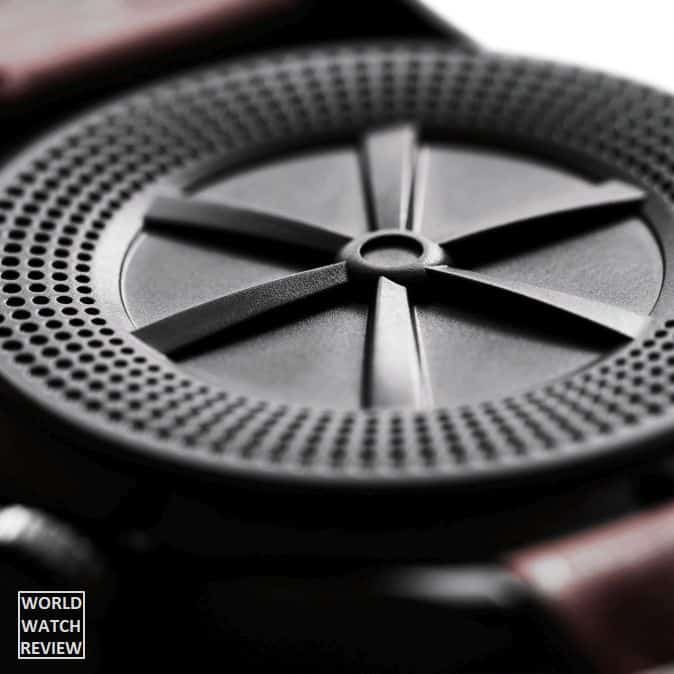
However, the mechanism is also expensive since, at this time, it is only available with their C9 5 Day Small Seconds (£1295 – (£1395), C9 5 Day Automatic three-hander (£1375 – £2275) and their signature C60 Trident Chronometer 600 homage to Submariner that retails for £1499 – £1660 depending on the checkboxes that you, um, check while building yourself a new timekeeper on their website. Or, perhaps, they don’t have a GMT module for it yet, which is more probable.
This new C8 UTC Worldtimer is considerably less expensive, so that may be the reason why the watchmaker decided to set the SH21 aside and use a cheaper and more time-proven ETA 2893-2 self-winding movement for this piece. On a side note, they also have their Caliber JJ03 (the same base ETA 2893-2 mechanism modified by Johannes Jahnke) that powered the aforementioned 2013 C900 Worldtimer GMT, but, again, for some reason decided to stick to the base movement. Not sure whether it was cost-cutting (the 2013 model was, too, expensive at £1575) or some technical problems with the complication module that they used here.
Anyway, the ETA 2893-2 is a great workhorse movement that, while not fancy in the features department, will still give you decades of hassle-free operation if you don’t forget to service it at specified intervals. With its guaranteed tolerance of +20/-20 seconds per day, it is good at keeping time, has an efficient winding system, and features a hacking second hand, which is great.
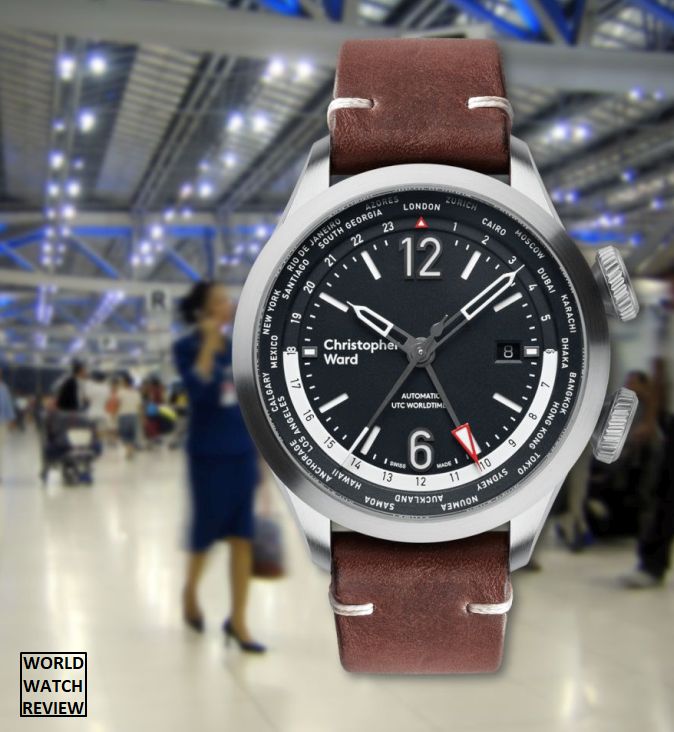
Yes, its official 42 hours of power reserve doesn’t look especially convincing if you compare it to 120 hours of the SH21, but it also makes the timekeeper a lot more affordable.
Pricing & Availability
At the time of writing of this review, the Worldtimer was offered at a price of £899 (including the VAT of £149.83, but not including delivery charges) for the version in stainless steel or £950 for the piece in matte black DLC steel. The collection is listed as a “pre-order” with shipping sometime in mid-October 2016.
While I have heard a lot of ranting about Christopher Ward’s new pricing policy (or, rather, about how outrageously overpriced their watches have become) I still think that the price is sort of competitive.
Yes, at approximately $1250 apiece the watch is no longer as affordable as their earlier timekeepers with similar functionality, but it is no longer a poor man’s Rolex either: this an original watch that was designed to look like an original watch and hence the higher price. You can always vote with your dollar (or other currency of your choice) if you don’t agree with their new pricing policy, but, again, I think that the MSRP is good for the level of sophistication you are offered.
See also: IWC Pilot Worldtimer Self-Winding (Ref. IW326201)
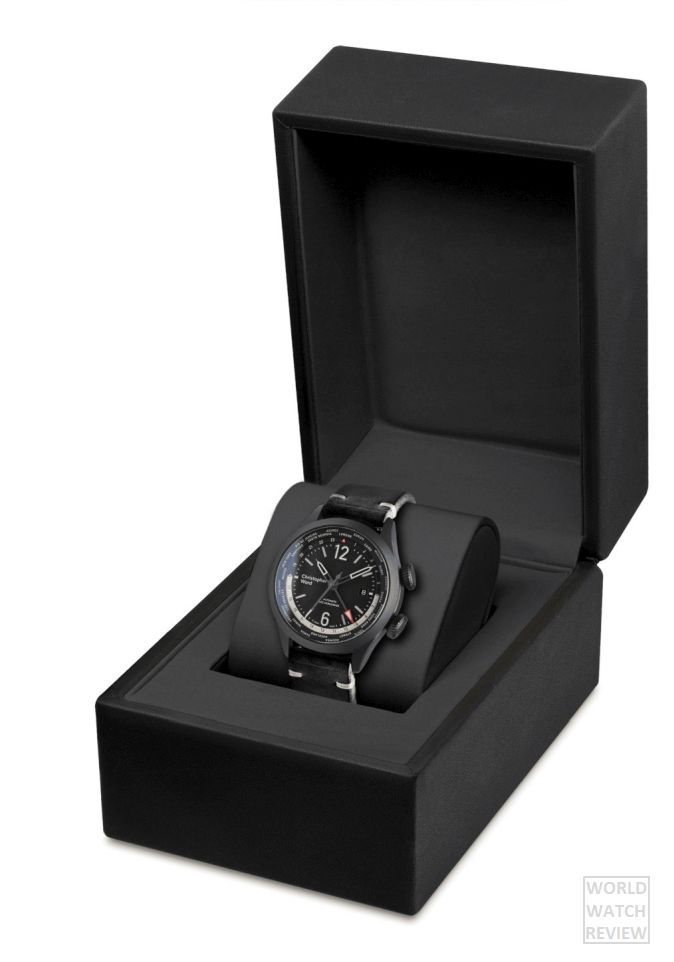
WWR Verdict
Originality 4.5/5
Build Quality: 5/5
Usability: 5/5
Overall Legibility: 4.5/5
Nighttime Legibility: 4.5/5
Value for Money: 4.5/5
Overall Rating: 4.5/5
Photos: Christopher Ward
Christopher Ward C8 UTC Worldtimer specification
Price:
£899 (MSRP, VAT included, refs. C8-44-GM-SK-T-B, C8-44-GM-SK-K-B, and C8-44-GM-SK-C-B in stainless steel)
£950 (MSRP, VAT included, refs. C8-44-GM-KVK-C-B, C8-44-GM-KVK-T-B, and C8-44-GM-KVK-K-B in black DLC-treated steel)
Winding: Automatic (self-winding)
Movement: Caliber ETA 2893-2, Swiss Made
Number of jewels: 21
Movement frequency: 28,800 vph
Power reserve: 42 hours
Functions: Hours, minutes, seconds, date, second time zone (GMT, UTC)
Case: Stainless steel / Black DLC Steel
Shape: Round
Size: 44.00 mm
Case height: 11.50 mm
Lug width: 22 mm
Dial: Black, with white or beige accents
Numerals: Arabic, luminous, applied
Hour markers: Luminous
Hands: Open-worked, pipette-type, luminous
Water resistance: 50 meters
Strap: Vintage finish leather strap with hand-sewn whip stitch and pin buckle
Crystal: Sapphire
Back: Solid, screw-in, Farnborough wind tunnel engraving
